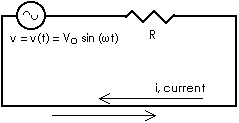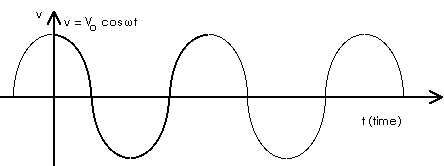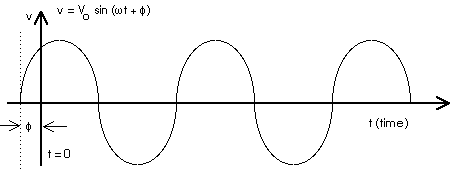

The voltage produced by a coil of wire which rotates in a magnetic field varies sinusodially with time,
where ![]() is the angular frequency of the rotation. All the other parameters or
characteristics of the circuit will also vary with time.
is the angular frequency of the rotation. All the other parameters or
characteristics of the circuit will also vary with time.

By convention or custom, we write these variables as lower case letters to remind us that they are functions of time. That is, we will write the voltage as v to indicate v(t) and we will write the current as i to indicate i(t). When we say the voltage varies sinusodially with time, we immediately think of writing it as a sine function,
But, with a different choice of when we decide to set t = 0, this same variation could be written as a cosine function,
There is no real difference in these two forms

Or we might have some arbitray choice of when we set t = 0 so that the sinusodially varying voltage can be written as
v = v(t) = Vo sin (![]() t
+
t
+ ![]() ) .
) .
![]() is
called the "phase angle" and is determined by when we decide to set t
= 0.
is
called the "phase angle" and is determined by when we decide to set t
= 0.

All the quantities involved with an Alternating Current (AC) circuit vary with time; they are functions of time. We usually indicate this -- and remind ourselves -- by writing these time-varying quantities with lower case letters like v or i. The value of a resistor does not change with time -- even for an AC circuit -- so we write that with a capital R. When we talk of power we usually mean the average value -- the rms value -- so that,too, is written with a capital PQuantities involved with a Direct Current (DC) circuit have values that are constant over time. Quantities for a DC circuit are usually written as capital letters like V, I, R, and P.
|
|
|
||
|
|
|||